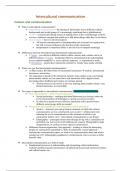Intercultural communication
Culture and communication
❖ What is intercultural communication?
➢ Intercultural communication = the sharing of information across different cultural
backgrounds and social groups (it’s increasingly significant due to globalization)
➢ Culture = a historically shared system of making sense of the world through symbolic
resources (abstract concepts that enable us to talk about things while they’re not there)
➢ Communication has two universal aspects:
▪ All human communication is interdependent (not everyone has equal power,
but still everyone influences the direction of the interaction)
▪ Interpretation is situational (there is not one way to interpret meanings)
❖ Differences between intercultural and international communication:
➢ 1: Scope – you can have different cultures within a nation, and a culture can be in
different nations | 2: Goals – facilitating effective communication & understanding
across cultural boundaries vs. serves specific purposes, i.e. negotiation or trade |
3: Orientation – mostly direct interaction oriented vs. mostly mass media oriented
❖ Where can you find intercultural communication?
➢ A) Mass media, B) Other forms of intercultural encounters → tourism, international
businesses, universities
➢ The separation is based on the interaction element: mass-media is one-way leaning
about another culture, as you cannot have real interaction with a digital screen,
preventing direct feedback and creation of common ground
▪ Tourism however can also be a one-way learning about another culture, very
limited interaction, in own bubble
❖ Two types of approaches to intercultural communication (culture and communication):
➢ Socio-psychological + skills-oriented approaches
▪ Social psychology = studying individual behaviour (psychology) under the
social circumstances of belonging to a group (social psychology)
▪ In order for a person to have effective interaction with a person from a
different social group, skills are needed
➢ Postmodern, ethnographically and interpretative-based approaches
▪ Modern = structure (you can go back to elements of which the cultural
communication act was constructed), post-modern = abstract (prevents
reducing the act of communication to the elements of which it was
constructed, holistic view; ‘intercultural communication is one thing’)
▪ Ethnography = participant observation through living with a community for
preferably one year (cycle of all traditions per season). Ethnographers make
interpretations, in contrast to more objective observations
➢ Difference between approaches: first approach = looking at where the interacting
people are coming from (quantitative, skills development), second approach =
studying the communication space, so what is the communication about and what is
coming out of it? (ethnography (qualitative), interpretation). One is not per se better
than the other
❖ Intercultural communication as a field of study:
➢ Fundamental processes in understanding and interpreting cultural information
(cultural symbols/concepts/interactions), all influenced by personal experiences/biases
and cultural norms, are:
, ▪ Selection → (sub)conscious act of choosing specific elements from the
environment to focus on
▪ Organization → selected cultural elements are categorized based on their
perceived similarities, differences, or relationships
▪ Evaluation → judging the worth, importance, or meaning of the organized
cultural information
➢ Hazards of studying intercultural study are oversimplification, overgeneralization, and
exaggeration. Being aware of these hazards is important, as it can help avoid
misinterpretation / misunderstanding and keeping a balanced perspective
❖ Concepts of cultural mixing (knowing is just handy for essay-type questions on the exam):
Diaspora The scattering of a group of people from their original homeland to other parts of
the world
(Re)territorialization The process of (re)asserting control over a particular territory through
// deterritorialization political/social/cultural boundaries // the weakening or breakdown of territorial
(political/social/cultural) boundaries, often due to globalization
Globalization // The increasing interconnectedness and interdependence of societies and economies
localization // on a global scale, facilitated by advancements in technology and communication //
glocalization the adaptation of global products and practices to local contexts or preferences (e.g.
McDonalds adapting menu and restaurant design to local contexts around the world)
// global and local forces interacting and influencing each other, resulting in hybrid
forms of culture, economy, or identity
Creolization // creole The blending and mixing of different cultural elements to create new cultural forms
and expressions, often associated with colonialism // a language that develops from
the blending of different linguistic influences, often associated with colonial settings
Hybridization The blending and mixing of different cultural elements to create new, hybrid forms
Mestizaje, métisse, Terms historically used to describe people that are mixed race (first one = Latin
mulatto American term)
Border zones Areas at the edges of nations, often experiencing a mixture of cultural influences. It
extents the concept of ‘borderlands’ as besides physical boundaries it also takes the
social/economic/cultural contexts into account
Cultural fronts // The leading edge of cultural change, which can emerge in various forms (e.g. social
cultural frontiers activism or artistic movements) // the boundaries where different cultural influences
meet and interact. Can be physical (e.g. area around nation borders) or conceptual
(e.g. intersection of belief systems)






